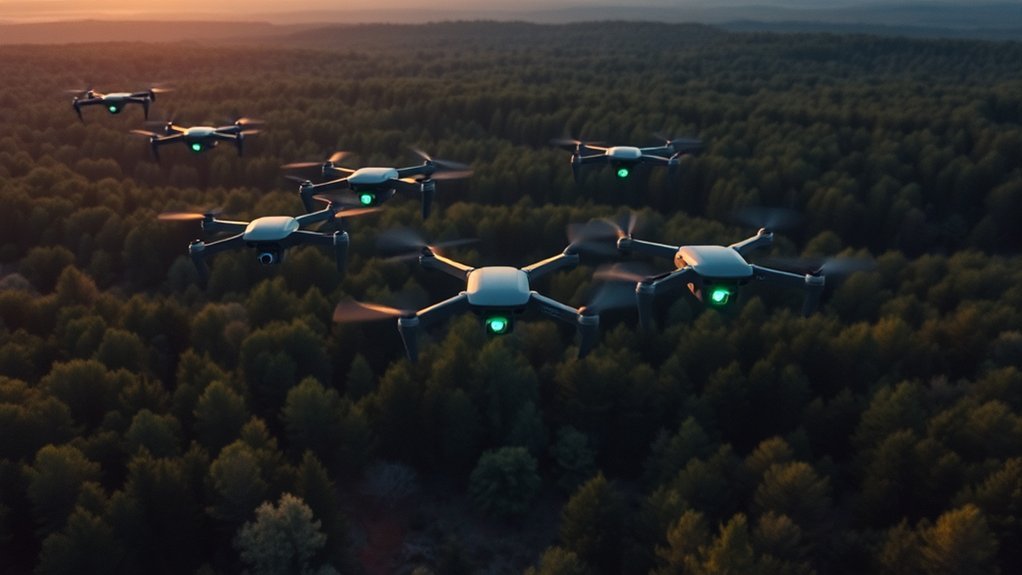Imagine a world where finding deer after a hunt is as easy as pressing a button. In 2025, the right thermal drone can transform your hunting experience, making recovery seamless and efficient. With advancements in technology, these drones offer features that streamline the process and enhance your success rate. But which models stand out in this new landscape? Let’s explore the top options that could redefine your approach to deer recovery.
Radiolink M435 Heavy Lift Drone
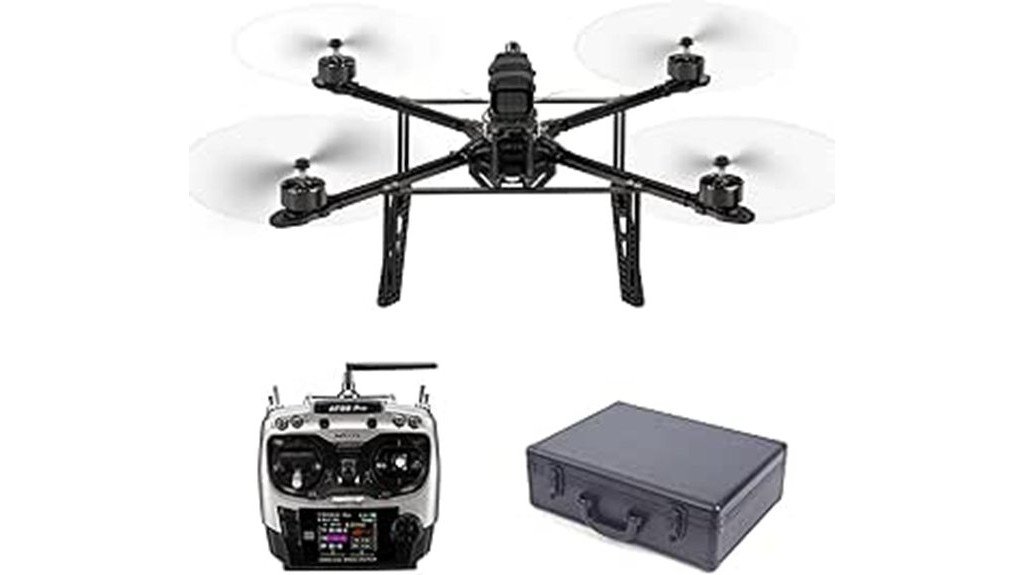
The Radiolink M435 Heavy Lift Drone stands out as an ideal choice for hunters focused on deer recovery, thanks to its impressive payload capacity of 3KG (6.6 lbs). With a flight speed of 120 km/h and a maximum range of 4KM (2.1 miles), you can quickly cover large areas while monitoring your surroundings. Its carbon fiber frame keeps it lightweight at just 2.1 lbs, ensuring durability and ease of transport. Equipped with autonomous features like auto takeoff and landing, plus flexible payload modes, this drone enhances your recovery efforts, making it an invaluable tool for any serious hunter.
Best For: The Radiolink M435 Heavy Lift Drone is best for hunters focused on deer recovery who require a reliable and efficient tool for transporting equipment and monitoring large areas.
Pros:
- High payload capacity of 3KG (6.6 lbs) allows for versatile transportation of gear.
- Autonomous features like auto takeoff, landing, and route planning enhance ease of use.
- Lightweight carbon fiber frame ensures durability without sacrificing portability.
Cons:
- Limited maximum range of 4KM (2.1 miles) may restrict usage in expansive hunting areas.
- Best Sellers Rank suggests it may not be widely recognized among competitors.
- Battery life may vary based on payload and flight conditions, potentially affecting operational time.
DEERC D65 2 Axis Mechanical Gimbal GPS Drone with Camera
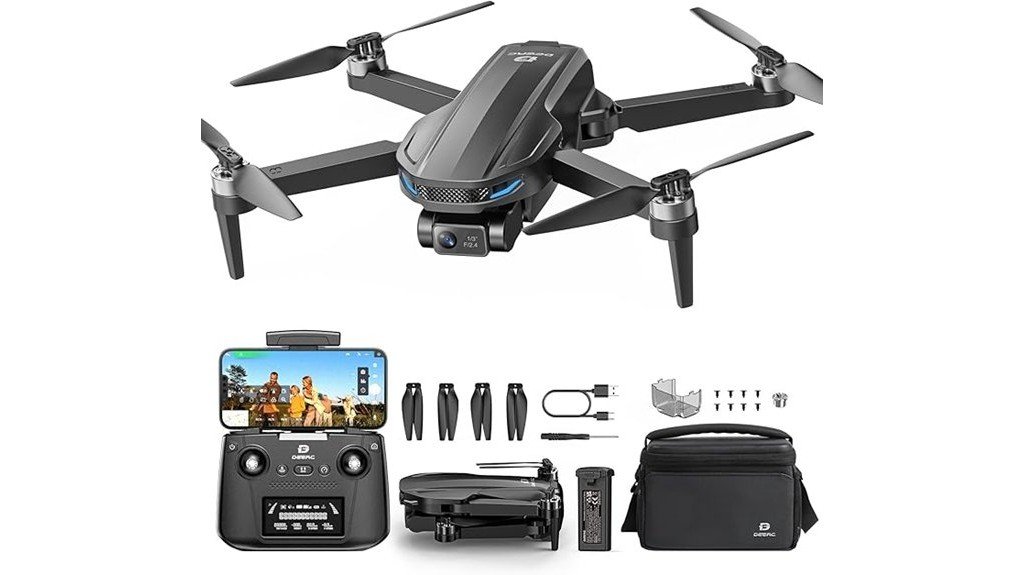
Looking for a lightweight drone to assist in deer recovery? The DEERC D65 is an excellent choice, weighing under 249g. With its 4K UHD camera and 2-axis mechanical gimbal, you’ll capture stable, high-quality footage. It offers smart flight modes like Follow Me and Waypoint Flight, making navigation easy and efficient. The battery lasts about 20 minutes, ensuring ample time for your search. Plus, the GPS-assisted features and return-to-home function add reliability. User-friendly controls make it perfect for beginners, so you can focus on enhancing your hunting game without hassle. Don’t miss out on this fantastic tool for deer recovery!
Best For: The DEERC D65 is best for beginner drone enthusiasts and hunters looking for an efficient tool for deer recovery.
Pros:
- Lightweight design under 249g makes it easy to transport and use without FAA registration.
- 4K UHD camera with a 2-axis mechanical gimbal delivers stable, high-quality video footage.
- User-friendly controls and smart flight modes enhance ease of use, making it suitable for beginners.
Cons:
- Some users have reported connection issues and occasional camera functionality problems.
- Moderate dynamic range may not meet the needs of those looking for high-end cinematic quality.
- The battery life of 20 minutes may be limiting for extended flight sessions.
E99 Drone with Screen Controller and Two Batteries
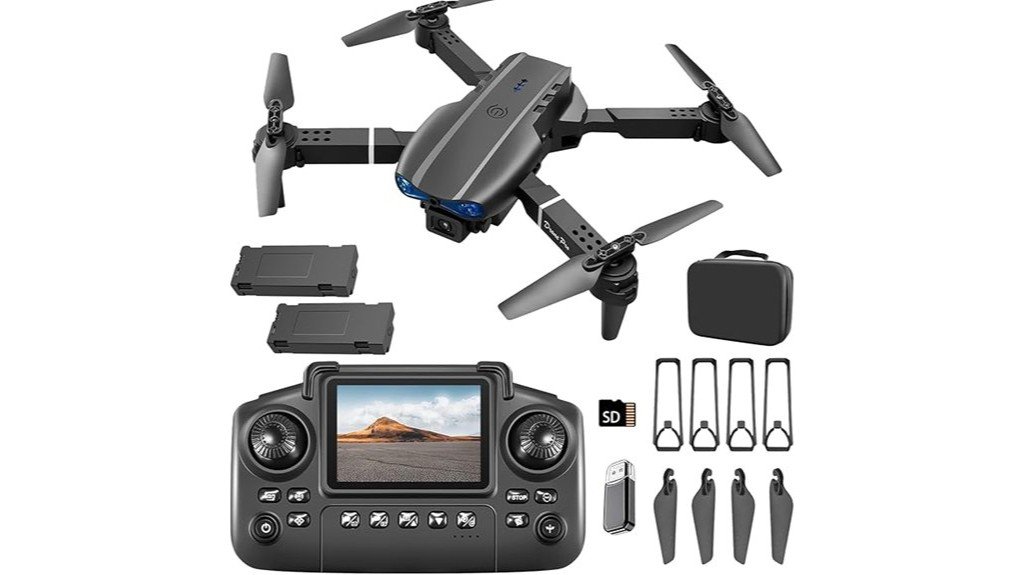
For hunters seeking an efficient tool for deer recovery, the E99 Drone stands out with its innovative screen controller and dual battery setup. Weighing just 6.4 ounces, this compact drone boasts a 1080P HD camera for sharp aerial footage. With two rechargeable batteries, you get up to 24 minutes of flight time. The one-key takeoff and altitude hold features make it user-friendly, while advanced tech like Active Obstacle Avoidance guarantees safe navigation. Plus, its foldable design and carrying case make it easy to transport, enhancing your hunting experience without hassle. Immerse yourself in your next hunt with the E99!
Best For: Hunters seeking an efficient aerial tool for deer recovery and monitoring.
Pros:
- Easy flight with responsive controls for seamless operation.
- High-definition 1080P camera for clear aerial photos and videos.
- Compact, foldable design and carrying case for convenient transport.
Cons:
- Small print instructions can be difficult to read.
- Potential for missing parts upon delivery.
- Limited camera adjustability during flight.
EM10-256 Thermal Monocular for Night Vision and Hunting
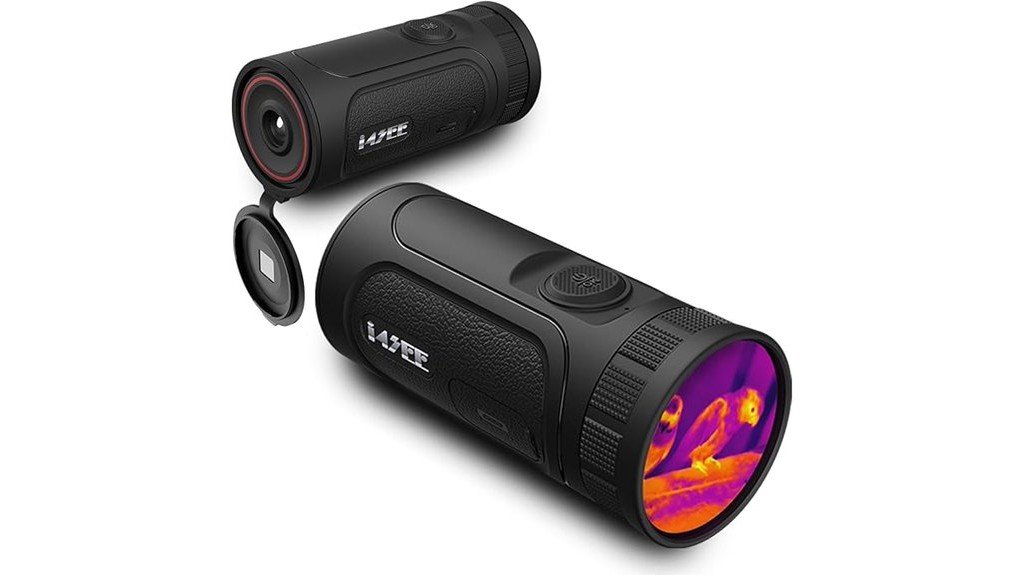
Equipped with a high-resolution 256×192 display and a powerful detection range of up to 500 meters, the i4SEE EM10-256 Thermal Monocular is a game-changer for hunters and outdoor enthusiasts. Its lightweight design and IP67 ruggedness make it perfect for all-weather use. With a 50Hz frame rate and various color palettes, you’ll experience clear imaging, reducing eye fatigue during long sessions. Enjoy up to 6 hours of battery life, and quick charging guarantees you’re always ready. Plus, smart connectivity options and audio-synced recording enhance your hunting experience, making this monocular an essential tool for your adventures.
Best For: The i4SEE EM10-256 Thermal Monocular is best for outdoor enthusiasts, hunters, and law enforcement personnel seeking reliable night vision capabilities.
Pros:
- High-resolution display allows for clear imaging in various conditions.
- Lightweight and compact design makes it easy to carry during outdoor activities.
- Smart connectivity options enable seamless integration with mobile devices for enhanced functionality.
Cons:
- Limited battery life of up to 6 hours may require frequent recharging during extended use.
- Resolution of 256×192 may not meet the needs of users seeking ultra-high-definition imaging.
- Price point may be higher compared to basic thermal monoculars on the market.
B50-640 LRF Thermal Binoculars for Hunting
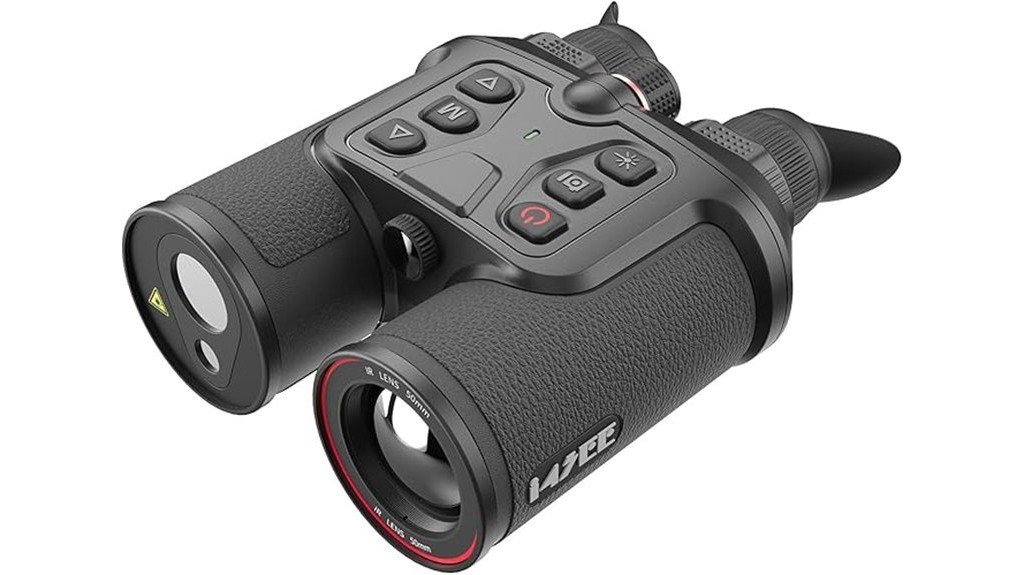
The B50-640 LRF Thermal Binoculars stand out for hunters seeking precision and clarity in their deer recovery efforts. With a 640×480 resolution sensor and a 50mm focal length, these binoculars deliver exceptional thermal imaging in any lighting. You’ll appreciate the laser rangefinder that surveys up to 600 meters, enhancing target identification. Their compact, durable design features an IP66 waterproof rating, making them perfect for any weather. The adjustable interpupillary distance and tactile buttons guarantee comfort and ease of use. Plus, with a five-year warranty, you can trust your investment in reliable performance during your hunting adventures.
Best For: The B50-640 LRF Thermal Binoculars are best for hunters and outdoor enthusiasts seeking high-quality thermal imaging and precision in their hunting activities.
Pros:
- Exceptional thermal imaging with a 640×480 resolution sensor for clarity in various lighting conditions.
- Durable design with an IP66 waterproof rating, ensuring reliability in adverse weather.
- Long battery life of up to 6 hours and a five-year warranty for peace of mind.
Cons:
- Higher price point compared to standard binoculars may not fit all budgets.
- May require some time to learn all features and settings for optimal use.
- Limited storage capacity of 16GB for images and videos may necessitate regular downloads.
E10-256 Thermal Monocular for Night Vision

When it comes to nighttime deer recovery, the i4SEE E10-256 Thermal Monocular stands out with its impressive detection range of up to 500 meters. Weighing just 248 grams, it’s compact and easy to carry, making it perfect for your hunting trips. The 256×192 resolution and 30mK NETD guarantee crisp thermal imaging, while the AMOLED display offers multiple color palettes for maximum visibility. With a six-hour battery life and quick charging capabilities, you won’t miss a moment. Plus, its IP67 rating means it’s built for all-weather durability, assuring you can count on it during your nighttime adventures.
Best For: The i4SEE E10-256 Thermal Monocular is best for hunters and outdoor enthusiasts looking for reliable night vision technology for tracking and recovery.
Pros:
- Compact and lightweight design makes it easy to carry on hunting trips.
- High-resolution thermal imaging with multiple color palettes enhances visibility in low-light conditions.
- Quick charging feature allows for extended use with just a short charging time.
Cons:
- Battery life of up to 6 hours may be limiting for extended nighttime outings.
- Slightly lower resolution compared to some higher-end thermal monoculars on the market.
- Requires WiFi or Bluetooth connectivity for full smart features, which may not be accessible in remote areas.
DJI Mini 3 Drone with 4K Camera
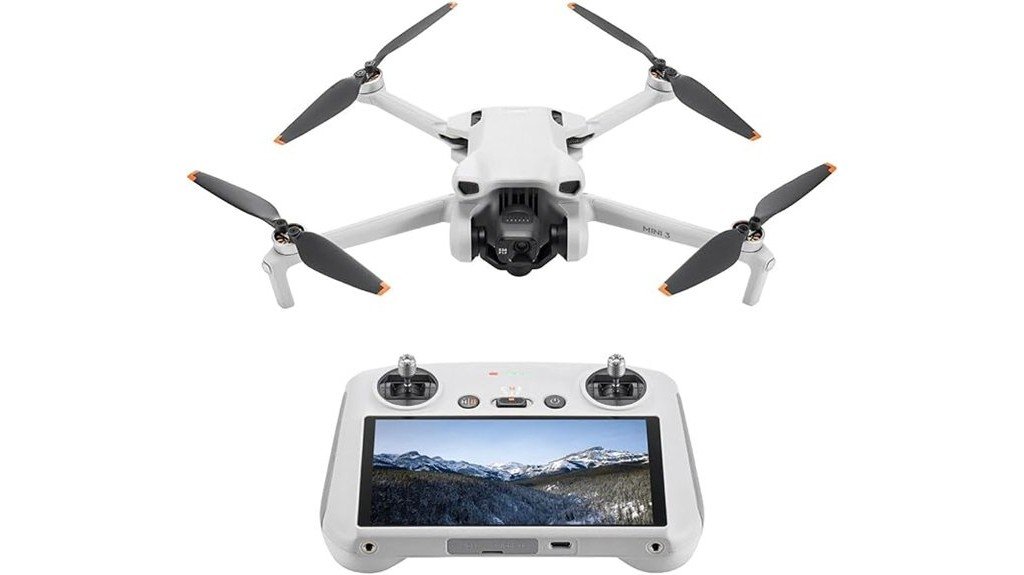
For hunters looking to enhance their deer recovery efforts, the DJI Mini 3 Drone with its impressive 4K camera stands out as a top choice. Weighing just 248 grams, you won’t need to register it for recreational use. With a flight time of up to 38 minutes, this drone captures stunning 4K UHD videos, even in low light. Its 3-axis gimbal guarantees stable footage, while level 5 wind resistance keeps you flying smoothly. Plus, the foldable design makes it easy to transport. The DJI Mini 3 is user-friendly, perfect for beginners aiming to up their hunting game.
Best For: The DJI Mini 3 Drone is best for hunters seeking to enhance their deer recovery efforts with a lightweight, user-friendly drone that captures high-quality aerial footage.
Pros:
- Excellent 4K UHD video quality, even in low light conditions.
- Lightweight design (248 grams) eliminates the need for registration for recreational use.
- User-friendly features make it suitable for beginners and easy to transport.
Cons:
- Limited to a flight time of 38 minutes under normal conditions; requires battery swaps for extended use.
- Does not include the Intelligent Flight Battery Plus, which is sold separately for longer flight times.
- Some users may need to familiarize themselves with local regulations regarding drone usage.
N11 Pro GPS Drone with Camera for Adults
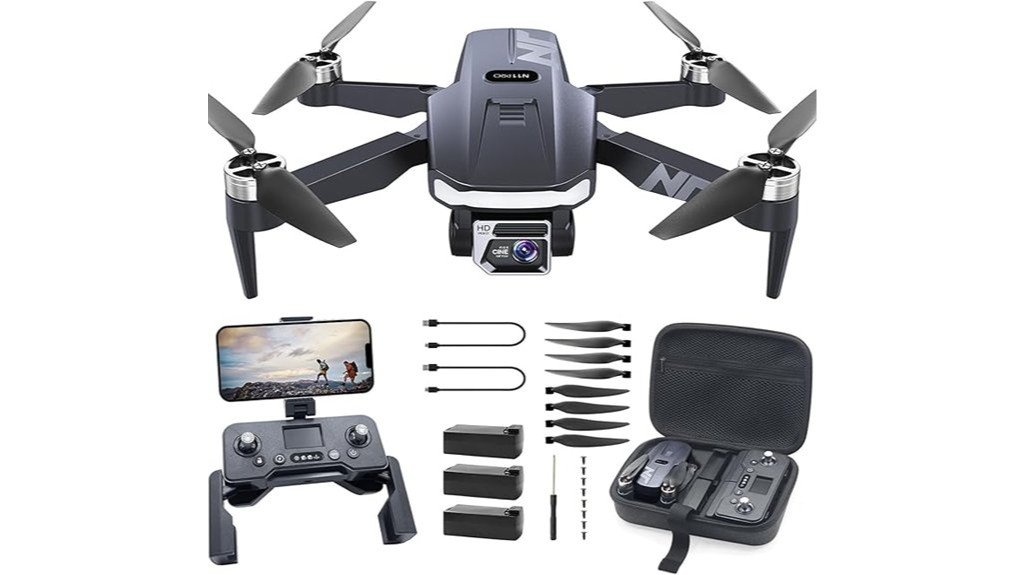
Equipped with a 4K UHD camera and an impressive 90-minute flight time, the N11 Pro GPS Drone is perfect for avid hunters and wildlife enthusiasts looking to enhance their deer recovery efforts. Its lightweight design guarantees you won’t need FAA registration, while the foldable structure makes it easy to transport. With intelligent tracking and a long-range control of up to 3328 feet, you can capture stunning visuals in real-time. The drone’s auto return feature guarantees safety during low battery or signal issues, making it a reliable companion for your hunting adventures. Enjoy seamless operation and stability, whether you’re indoors or outdoors.
Best For: Avid hunters and wildlife enthusiasts looking for a reliable and portable drone to enhance their deer recovery efforts.
Pros:
- High-quality 4K UHD camera for stunning visuals and real-time streaming.
- Long battery life of 90 minutes with three batteries, allowing extended flight times.
- Lightweight and foldable design for easy transport and no need for FAA registration.
Cons:
- Limited range of 3328 feet may restrict usage in large open areas.
- Requires practice for beginners to master all features effectively.
- Durability concerns in extreme weather conditions may arise despite robust materials.
M10-256 Thermal Imaging Monocular for Hunting
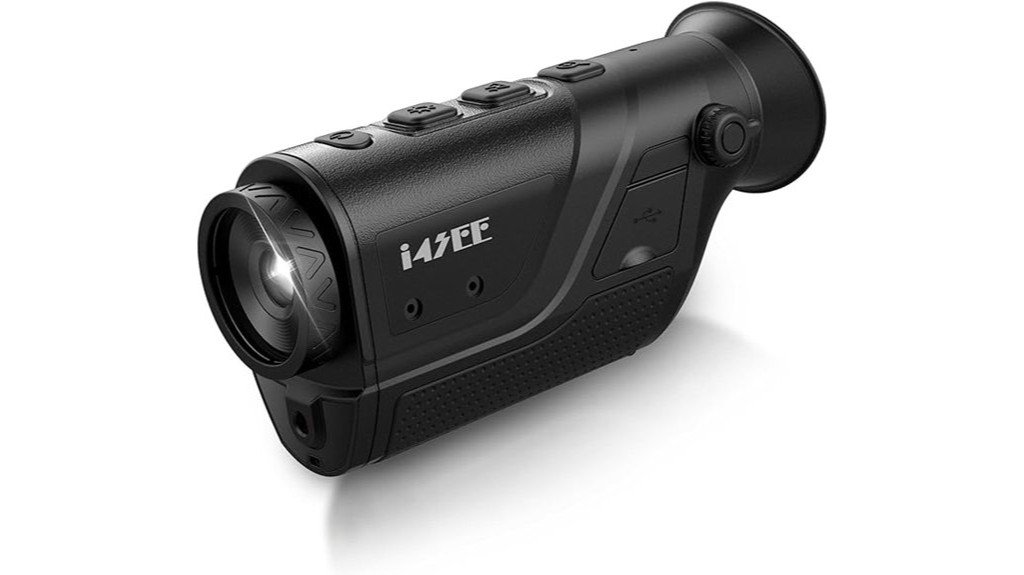
The M10-256 Thermal Imaging Monocular stands out as an essential tool for hunters focused on deer recovery. With a 10mm focal lens and a resolution of 256×192, it offers impressive thermal imaging capabilities. You can spot deer up to 400 yards away and detect them at 1000 yards. Weighing just 2.99 pounds, it’s easy to handle in various weather conditions, thanks to its IP66 waterproof rating. Enjoy up to 12 hours of battery life and five display modes to suit your needs. Plus, with WiFi connectivity, sharing real-time images is seamless. This monocular is a game-changer for your hunting adventures.
Best For: Hunters focused on deer recovery and outdoor enthusiasts looking for a reliable thermal imaging tool.
Pros:
- Lightweight design enables easy one-handed operation.
- IP66 waterproof rating ensures durability in harsh weather conditions.
- WiFi connectivity allows for real-time thermal image sharing.
Cons:
- Some users report image distortion when targets are not centered in the viewfinder.
- Mixed reviews on thermal detection effectiveness at longer ranges.
- Performance is noted to be better within 100 yards, limiting long-distance use.
MiLESEEY Thermal Monocular T-Recon Scout
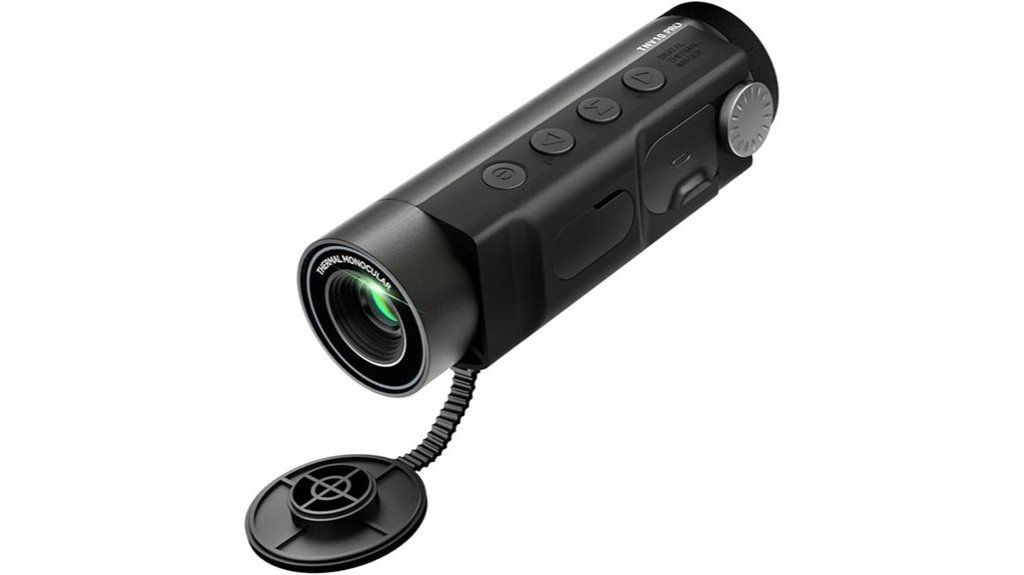
Hunters looking for an efficient tool to aid in deer recovery will find the MiLESEEY Thermal Monocular T-Recon Scout particularly useful. This handheld device boasts a 320×240 resolution and a 12μm infrared detector, delivering smooth visuals with a 50Hz refresh rate. With five flexible visual modes and Hotspot Tracking, you’ll easily spot your target. The durable design withstands tough conditions, while the 4500mAh battery allows for up to 12 hours of use. Plus, its 32GB built-in memory lets you record hours of footage. Users rave about its clear images and compact portability, making it a valuable addition to your hunting gear.
Best For: Hunters looking for an efficient tool to aid in deer recovery and enhance their night vision capabilities.
Pros:
- High-resolution 320×240 display with a 50Hz refresh rate for smooth visuals.
- Durable design with IP65 rating for water and dust resistance; operates in extreme temperatures.
- 32GB built-in memory for extensive video recording and snapshot storage.
Cons:
- Narrow field of view may limit visibility in certain scenarios.
- Some users report image clarity issues at close distances.
- Lack of a screen dimmer can make it difficult to use in bright environments.
Factors to Consider When Choosing a Thermal Drone for Deer Recovery
When choosing a thermal drone for deer recovery, you need to take into account several key factors. Thermal imaging resolution, detection range, and battery life all play vital roles in the effectiveness of your search. Additionally, weight, portability, and user-friendly controls can greatly affect your overall experience.
Thermal Imaging Resolution Importance
Clarity in thermal imaging resolution is important for effective deer recovery. The resolution, measured in pixels, directly impacts the detail of thermal images you capture. For instance, entry-level devices typically offer 256×192 pixels, while higher-end models provide 640×480 pixels, enhancing your ability to identify targets at greater distances. A higher resolution distinguishes heat signatures more effectively, essential for spotting deer against varied backgrounds. Additionally, consider the NETD rating, which indicates thermal sensitivity; lower values mean better detection of subtle temperature differences. In practical applications, a device with 640×480 pixels and a NETD below 30mK greatly boosts your chances of locating deer in dense cover or low-light conditions, making resolution a key factor in your thermal drone choice.
Detection Range Considerations
Detection range plays a critical role in selecting a thermal drone for deer recovery. A longer detection range, ideally up to 500 meters (550 yards) or more, allows you to identify heat signatures from a distance, which is especially useful in expansive hunting areas. When evaluating drones, don’t overlook the resolution of the thermal sensor; higher resolutions like 640×480 enhance image clarity, making it easier to spot deer among their surroundings. Additionally, the refresh rate, typically around 50Hz, affects how smoothly you can track moving deer. Finally, remember that environmental factors like temperature differences and weather conditions can impact detection range, so choose a drone that performs well across various conditions for best results.
Battery Life and Endurance
While choosing a thermal drone for deer recovery, battery life and endurance are crucial aspects that can make or break your search efforts. Look for models that offer up to 12 hours of continuous operation on a single charge, allowing you to maximize your time in the field. Lithium batteries typically provide better performance and longer life than other types, so prioritize those. Quick charging capabilities also enhance usability, letting you recharge between flights swiftly—essential for time-sensitive recoveries. Additionally, drones with power management systems can optimize battery usage, extending flight times under demanding conditions. Finally, consider the average flight time in relation to the drone’s weight and payload capacity, as heavier loads can diminish overall endurance.
Weight and Portability Factors
When selecting a thermal drone for deer recovery, weight and portability are key factors that can greatly influence your experience in the field. Lighter models, often under 250 grams, are easier to carry during outdoor missions. Look for compact designs with foldable features, allowing for convenient storage in standard backpacks. Keep in mind that battery weight affects portability; larger capacities extend flight time but add weight. Additionally, materials like carbon fiber help reduce overall weight while providing durability against harsh conditions. Finally, consider how easily the drone assembles and disassembles. Quick setup and pack-away capabilities are essential, especially when traversing rugged terrains. Prioritizing these aspects will enhance your recovery efforts and overall hunting experience.
User-Friendly Control Features
How can you guarantee a smooth and efficient drone operation during deer recovery? Look for user-friendly control features that make the process simple, especially if you’re not tech-savvy. One-key takeoff and landing functions are essential, allowing you to focus on tracking rather than fumbling with controls. GPS-assisted navigation helps maintain stability and accuracy, vital for effective deer recovery. Intuitive controls like altitude hold and waypoint flying let you position the drone perfectly for thermal imaging without constant adjustments. Real-time video transmission improves your situational awareness, ensuring you stay aware of your surroundings. Finally, choose drones with beginner-friendly interfaces for easy setup and quick calibration, so you’re ready to go when the pressure’s on.
